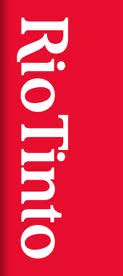 Rio Tinto chief executive Tom Albanese said “This was another year of strong operational performance across the Group. We achieved record annual iron ore production and shipments as our expansion programme continues on schedule, delivering industry leading returns for our shareholders. Our copper, bauxite, alumina, thermal coal and titanium dioxide businesses all delivered substantial production increases on 2011 levels.
Rio Tinto chief executive Tom Albanese said “This was another year of strong operational performance across the Group. We achieved record annual iron ore production and shipments as our expansion programme continues on schedule, delivering industry leading returns for our shareholders. Our copper, bauxite, alumina, thermal coal and titanium dioxide businesses all delivered substantial production increases on 2011 levels.
“Markets remain volatile, but our business continues to perform well. Across the Group we are taking action to roll back unsustainable cost increases. This further enhances our resilience and competitive edge as we enter 2013.”
• Record global iron ore shipments of 247 million tonnes (100 per cent basis) were achieved in 2012 despite severe weather disruptions and a significant maintenance shut-down during the year. Global iron ore production for the full year was 253 million tonnes (Rio Tinto share 199 million tonnes), four per cent higher than 2011. Pilbara iron ore production of 239 million tonnes (Rio Tinto share 191 million tonnes) set another annual record, four per cent higher than in 2011. Current nameplate capacity in the Pilbara has risen from 225 Mt/a at the start of 2012 to 237 Mt/a through de-bottlenecking and productivity improvement, with minimal capital spend.
• Total mined copper production for 2012 was six per cent higher than in 2011, due to expected recovery in ore grades at Kennecott Utah Copper and Escondida. Refined copper production improved at Kennecott Utah Copper following scheduled smelter maintenance during the second quarter.
• On 5 November 2012 Rio Tinto announced that Oyu Tolgoi had signed a binding agreement with a Chinese power company for the supply of electricity to Oyu Tolgoi. Commissioning of the ore-processing equipment began in mid-November and first ore was processed through the concentrator on 2 January 2013. First concentrate production will follow within one month and commercial production is expected to commence by June 2013.
• Bauxite and alumina production in 2012 were 11 per cent and 12 per cent higher than 2011, driven by increased third party demand for bauxite and expanded refining capacity at Yarwun. Aluminium production was 10 per cent lower than in 2011, as ramp up to normal capacity continued following resolution of the Alma labour dispute.
• Thermal coal production for the full year was 16 per cent higher than in 2011, reflecting increased plant capacity at Bengalla, the continued ramp-up at Clermont and the reversal of one-off disruptions in the fourth quarter of 2011. Hard coking coal production was nine per cent lower than in 2011, due to the impact of planned dragline maintenance at Hail Creek and a major preparation plant shutdown at Kestrel as part of its mine expansion project.
• Titanium dioxide feedstock production for the full year increased 11 per cent from 2011 following a successful furnace rebuild at Rio Tinto Fer et Titane and an increase in attributable volumes from Richards Bay Minerals (RBM).
• During the quarter, Rio Tinto announced further sales of non-core businesses, including a binding agreement to sell its interest in Palabora Mining Company, and the completion of the sales of the Lynemouth Power Station and the Chinese portion of its Alcan Cable business.
All currency figures in this report are US dollars, and comments refer to Rio Tinto’s share of production, unless otherwise stated
About Rio Tinto
Rio Tinto is a leading international mining group headquartered in the UK, combining Rio Tinto plc, a London and New York Stock Exchange listed company, and Rio Tinto Limited, which is listed on the Australian Securities Exchange.
Rio Tinto’s business is finding, mining, and processing mineral resources. Major products are aluminium, copper, diamonds, thermal and metallurgical coal, uranium, gold, industrial minerals (borax, titanium dioxide and salt) and iron ore. Activities span the world and are strongly represented in Australia and North America with significant businesses in Asia, Europe, Africa and South America.
